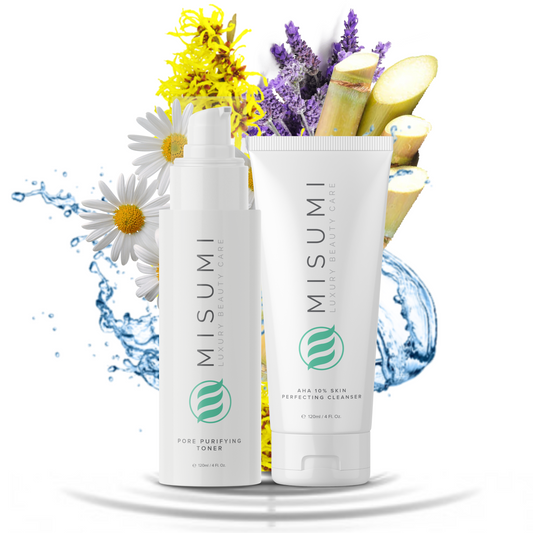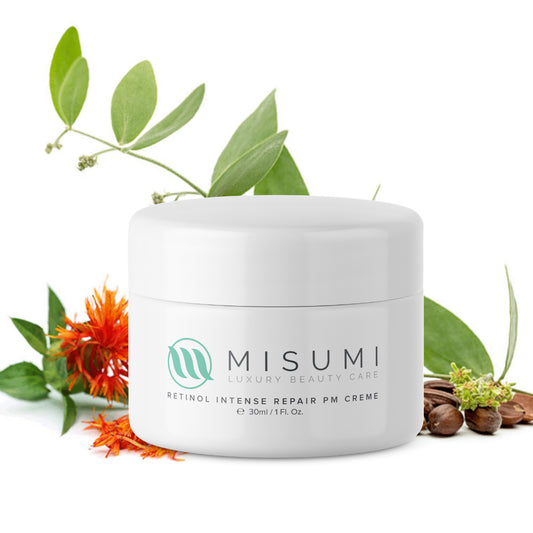Oops. You didn't do a patch test for a new skincare product, and it turned out you had bad luck. Don't worry - you're not alone. It's safe to say that we've all been there.
We all know the feeling. You finally got your hands on that new, hyped-up anti-acne or skin care product. You're giddy with excitement and anticipation, barely able to hold yourself back from tearing open that beautiful, shiny package! Finally, you slather the new, silky goo all over your face, reveling in the feeling of victory - you'll reap those benefits soon. Your skin will be fresher, younger, smoother, cleaner, and better.
And then the burning starts. The itching crawls all over your skin, like a thousand tiny invisible ants marching across your face. Your face is all pink and sore. You wash it off as anger and confusion set in. That supposedly amazing new product didn't make your face look better; it only made it look worse.

Hindsight is 20/20, and it becomes clear to us far too late. And, while we can't help that buyer's remorse (shops rarely accept the return of used skin care products), we can at least spare ourselves some undue suffering.
How? By patch testing each new skin care product, or even our home remedy, before we use it on our skin. These tests are known as patch tests, and we'll tell you all you need to know about them.
Make sure you know all the ingredients that go into a product. Misumi always makes sure to list its ingredients, whether that's in the AHA 10% Skin Perfecting Cleanser or the Clear Skin Salicylic Acid Cleanser.
Without further ado, get the down low on everything to do with patch testing.
What Is A Patch Test?
In short, it means testing new products or specific ingredients on a small patch of skin (hence, 'patch' test) to determine whether it's safe before using it on a wider area of skin.
This doesn't just apply to facial products. These products can be anything: from lip balms, moisturizers, sunscreens, face masks, cleansers, serums, gels, creams, spot treatments, to exfoliators and homemade remedies.
Everything that's intended for your skin can be tested first. Yes, that includes natural ingredients, such as vegetables, fruits, animal-derived substances, and even vitamins and minerals.

When it comes to skincare, you always need to test even the safest and most natural ingredients. Just because you can eat it, that doesn't mean that your skin won't react to it. And just because a skin care product is widely used, it doesn't mean that you won't have an allergy to it.
However, not all products are equally likely to provoke an allergic reaction. Synthetic fragrances or dyes, for example, alongside preservatives, sulfates, phthalates, and parabens, are known to cause reactions much more often than other ingredients. The problem is that a large number of skin care products contain at least one of these types of ingredients, making a patch test almost a necessity.

On the other hand, people with oily skin should be on the lookout for specific products rich with heavy emollients. These ingredients can mess with skin oil (sebum) production, leading to excessive oiliness, clogged pores, and acne breakouts. you should always patch-test cosmetic products that contain coconut butter, coconut oil, lanolin, cocoa butter, and isopropyl palmitate (derived from palm oil).
To avoid harm - or embarrassment - you can do a patch test first to see if any symptoms develop. It's the ultimate test of self-care.
But wait, are all patch tests the same?
Three Types Of Patch Tests
Nope, they're not. While patch tests always have the same purpose, i.e., testing a product on a patch of your skin to see how your skin will react, the reactions themselves are what sets patch tests apart.
These reactions will depend on what you're trying to achieve or, conversely, if a reaction occurs, what to avoid. For example, if you're looking for something that will moisturize your skin, but the product doesn't seem to work or makes your skin flaky, that's how you know that product isn't for you.

For the sake of usefulness and practicality, patch tests can be divided into three different kinds of tests: irritation patch tests, allergic reaction patch tests, or comedogenicity patch tests (important for people with acne).
Each patch test category comes with a body part best suited for performing the specific test. Additionally, you can create a sort of DIY patch test, depending on your specific need or intent. For example, you can try a sunburn patch test, where you apply a little amount of sunscreen on an area of your body and then compare the results.
Here are the three main types of patch tests, how to perform them, and what you should know about them.
Irritation Patch Test
The skin can react in different ways. A skin allergy (also known as allergic contact dermatitis) is not the same as an irritant contact dermatitis - the difference is that an allergic reaction involves the body's immune system, while irritation doesn't.
If your skin becomes irritated, the reaction is usually skin-deep, and it mostly has to do with the level of sensitivity of your skin. So, people with sensitive skin might need to perform patch tests to check if a cosmetic product, or a substance, will be too "strong" for their skin. This is a good test to do if you use products with essential oils.
Here's how to perform a patch test - especially for substances that are problematic.

First, choose an area of your skin that you find typically sensitive. For example, if your sensitive area is your cheeks, they would be a good place to test whether your skin will be irritated by a cosmetic product or an ingredient. If you do not want to test products on your face, try patch testing on your inner arm or somewhere else hidden from view.
After identifying the patch of skin for the test, take a tiny amount of the product and apply it to a quarter-sized patch of skin. Sometimes you'll see an immediate reaction, but if you don't, cover the area with a bandage.
Keep it covered for at least 24 hours. After the time passes, remove the bandages and check what your skin looks like. Does it look normal? Do you feel any itching, pain, or sensitivity? If everything looks and feels fine, chances are the product is pretty safe for you.
Keep in mind that some cosmetics or products will take a longer time to irritate your skin, even for those with sensitive skin. For this reason, it's a good idea to keep the substance on your skin for several days (or at least 72 hours). You can apply a drop or two every day if you wish.

On the other hand, certain types of products are meant to cause mild irritations, regardless of your skin type. Some substances contain some natural acids or are natural acids themselves. Common skin care and anti-acne products frequently contain these kinds of substances, like salicylic acid, glycolic acid, lactic acid and so on.
Usually, these reactions last for a short time (an hour at most) and are harmless. However, if the reaction lasts for a longer period of time after patch testing, you should stop using the product. As always, it's a good idea to discuss these reactions with your doctor or dermatologist.
Allergic Reaction Patch Test
An allergy is different from skin irritation. While irritation is not consistent and can sometimes be thoroughly eliminated (by improving your skin's health and lowering its sensitivity), this is not the case with allergies.
When you experience irritation, the problem is your skin. However, when you're experiencing an allergy, the problem is foreign material to which your body is reacting.

Allergies happen when your immune system reacts to a foreign substance that it finds problematic. This reaction can be intensely severe, causing a number of inflammatory processes. Your body is basically entering fight mode, sending an army of its antibodies to attack and destroy, whatever the offending substance may be. In the process, your immune cells happen to attack your own cells too, causing all sorts of problems.
Common allergens include pollen, bee venom, or animal proteins (usually found in all that pet fur floating around). A person can be allergic to foods that most people have no issue with, like the notorious peanut or strawberry allergies.
As you know, allergies to food can sometimes even be lethal (because they can contract the airways, choking a person), so this is not something to take lightly.
But thankfully, when it comes to a skin allergy (or a contact allergy), things are far from lethal. They can be severely unpleasant, embarrassing, inconvenient, and even painful.
Typical reactions include redness, allergic contact dermatitis (otherwise known as a rash), itchiness, flakiness, and peeling. Sometimes, if the reaction is more severe than usual, your skin can even swell and hurt.

So, how do you perform a patch test for skin allergies? Since allergies don't just appear on a specific area of the body but involve a system-wide reaction, you don't need to look for an irritable area.
For some reason, the skin behind our ears is the most reactive when it comes to allergies. When performing a professional patch test, dermatologists usually do so on the back of the patient, applying a wide range of different ingredients.
Take a tiny amount of the product you wish to test. Apply it to the skin right behind your ear, and rub it a little. Then, of course… wait for the test results.
For how long? Well, some allergy symptoms don't take long to make themselves known, so you can expect a reaction anywhere from 5 minutes to 72 hours. Usually, waiting for 24 hours is a good rule of thumb, but if you want to be super certain, you can give it several days. Dermatologists typically leave products on the patients for 48 hours.
If you're experiencing a severe allergic reaction, don't use that product or specific ingredient. If you experience mild allergic reactions that you deem bearable, it's best to consult with your doctor and dermatologist on what to do. And, of course, if you experience no inconveniences, pain, or an itchy rash, feel free to use the skincare product or ingredient.

Comedogenicity Patch Test (Acne Patch Test)
Is your acne getting bad again? Or maybe this time, you had one of those unexpected breakouts? But wait, you follow a healthy lifestyle, you're eating lean, exercising, and keeping good hygiene… but then, boom. A sudden acne inflammation out of nowhere. What gives?
Well, you'd be surprised at how big of a role your skincare products (and even home remedies) play in making your skin worse and causing acne to develop.
Why does this happen? Well, not everyone has the same skin, which means that not all products will work for everyone's skin. And if you're having unexplained breakouts of adult acne, chances are a skincare product might be the perpetrator.
So, if you're worried that a skincare product or a home remedy might cause you acne or other skin conditions, it's best to perform a comedogenicity patch test before using it. In case you're confused, comedogenicity here means "something that's likely to clog your pores."
For a product or an ingredient to be comedogenic, it has to cause clogged pores. Conversely, products that don't clog your pores are called non-comedogenic.

Alright, so, how do you go about patch-testing whether a popular moisturizer is comedogenic?
First, you need to pick a suitable location for the comedogenicity patch test. And in order to observe the results sooner, we recommend you choose a small area that's prone to acne. For example, if you're having frequent acne breakouts in the area around your nose or neck, then these are the areas you'll need.
So, how do you perform a comedogenicity patch test?
It's pretty similar to any other patch test, the difference being in the results you're watching for.
Take any amount of the product, and apply it to the desired area. In the case of a comedogenicity patch test, you don't need to be careful with the amount because you want to see if the product will clog your pores. (Of course, if you suspect that the product, or substance, you are testing may cause you a reaction or irritation, then a small amount is preferable).
Apply the substance to the desired area, then wait.

Since clogged pores and possible acne inflammation takes a while to develop, this type of patch test will last longer than the others.
You can continue testing the product for a week or so and then check the results, preferably under a magnifying mirror. If your skin seems normal and your pores don't show any signs of clogging or darkening, you're all good, and you can continue using the product.
However, if your pores have become clogged, and you're seeing blackheads and whiteheads forming, forming, you should stop using the product. We don't need to tell you what to do if it causes a full-blown acne inflammation, right?
Conclusion
Regardless of whether you have apprehensions about any new product or skincare substance, the wise thing to do is perform a patch test. You never know what your skin will react to.
Patch testing is fairly straightforward - pick a spot, apply a small amount of the substance, and wait. If all goes well and you don't experience any adverse reactions, congratulations! You can continue using that product without a care in the world.
However, stop using that product immediately if your skin reacts unpleasantly, causing redness, becoming itchy, flaky, dry, or even swollen and painful. A visit to your doctor or dermatologist will be a great help, too. Medical professionals can tell their patients what happened and what to avoid in the future.
This information is meant to supplement, not replace advice from your doctor or healthcare provider and is not meant to cover all possible uses, precautions, interactions or adverse effects. This information may not fit your specific health circumstances, and its goal is to offer a general view of the subject. In case you are suffering from a severe case of acne, you should consult with a dermatologist or a certified medical professional.








